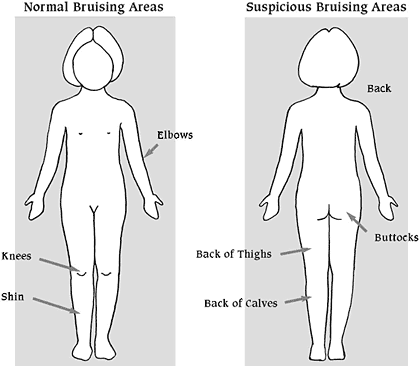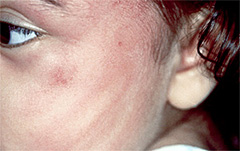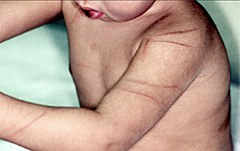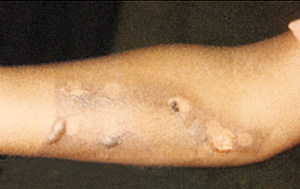RECOGNIZING PHYSICAL ABUSE
Physical Indicators of Physical Abuse
BRUISING
Some bruises indicate likely child abuse. It is important to know both normal and suspicious bruising patterns when assessing children’s injuries. Normal bruising usually occurs in the front of the body over bony areas such as the forehead, knees, shins, and elbows.
The “TEN-4 rule” (see below) is a mnemonic aid to remember when bruising requires immediate evaluation. Children who are under 4 years should not have any bruises in these areas, and infants under 4 months should have no bruises anywhere. The size of the bruise is not as important as the location.
| T | Torso |
|---|---|
| E | Ears |
| N | Neck |
| 4 | Under 4 |
Suspicious bruises include the following;
- Bruises on babies who are not yet mobile (“cruising”)
- Bruises on the ears, neck, eyes, cheeks, buttocks, or torso (torso includes chest, back, abdomen, genitalia)
- Bruises that are clustered or patterned (e.g., handprints)
(Norton Children’s, 2020)

Normal and suspicious bruising areas. (Source: Research Foundation of SUNY, 2011.)

This pattern signals the blow of a hand to the face of a child. (Source: Research Foundation of SUNY, 2011.)

Regular patterns reveal that a looped cord was used to inflict injury on this child. (Source: Research Foundation of SUNY, 2011.)
LACERATIONS OR ABRASIONS
Typical indications of unexplained lacerations and abrasions that are suspicious include:
- On the face, lips, or mouth
- To external genitalia
BURNS
Unexplained burns include:
- Cigar or cigarette burns, especially on soles, palms, back, or buttocks
- Immersion burns by scalding water (sock-like, glove-like, doughnut-shaped on buttocks or genitalia; “dunking syndrome”)
- Patterned like an electric burner, iron, curling iron, or other household appliance
- Rope burns on arms, legs, neck, or torso

A steam iron was used to inflict injury on this child. (Source: Research Foundation of SUNY, 2011.)
FRACTURES
Unexplained fractures may include:
- Fractures to the skull, nose, or facial structure
- Multiple or spiral fractures
- Fractures in various stages of healing
(SD DSS, 2020)
HEAD INJURIES
Typical indications of unexplained head injuries include:
- Absence of hair and/or hemorrhaging beneath the scalp due to vigorous hair pulling
- Subdural hematoma (a hemorrhage beneath the outer covering of the brain, due to severe hitting or shaking)
- Retinal hemorrhage or detachment, due to shaking
- Whiplash or pediatric abusive head trauma (see box below)
- Eye injury
- Jaw and nasal fractures
- Tooth or frenulum (of the tongue or lips) injury
PEDIATRIC ABUSIVE HEAD TRAUMA
Pediatric abusive head trauma (AHT) is an inflicted head injury in children that can be caused by various mechanisms, including rotational and contact forces to the head as well as shaking. The prevalence is between 32 and 38 cases per 100,000 children who are under the age of 1 year. AHT is fatal in nearly 25% of cases.
Secondary brain injury may occur as a result of hypoxia, ischemia, or inflammation, and up to 70% of survivors have sequelae. Impairments that result from AHT may include encephalopathy, intellectual disability, cerebral palsy, cortical blindness, seizure disorders, behavior problems, and learning disabilities. Endocrine dysfunction is commonly seen in survivors of AHT and may be observed years after the event.
The clinical presentation of infants or children with AHT can vary. Findings may be subtle and include:
- Bruising (see “TEN-4 Rule” above)
- Oral injuries such as frenulum tears
- Retinal hemorrhages that are numerous, found in all layers of the retina, extend to the periphery of the retina, or retinoschisis (blood in the macula)
- Skull fractures
- Cerebral edema
- Subdural hemorrhages
- Spinal subdural hemorrhages
AHT should be considered when infants or young children present with:
- Fussiness or altered mental status
- Vomiting
- Apnea
Short falls (less than 5 feet) are often the explanation given to the provider for the injury, however serious injury or death is unlikely to result from a short fall. In addition to conducting a thorough examination with imaging when AHT is suspected, clinicians should report to Child Protective Services and educate parents about the dangers of AHT from shaking or striking a child or impacting the child’s head against a surface. It is also important to educate parents about alternatives to soothe a crying baby (Narang, 2020).
Behavioral Indicators of Physical Abuse
Careful assessment of a child’s behavior may also indicate physical abuse, even in the absence of obvious physical injury. Behavioral indicators of physical abuse include the following:
- Withdrawal from friends or usual activities
- Changes in behavior (e.g., aggression, anger, hostility, or hyperactivity)
- Changes in school performance
- Depression, anxiety or unusual fears, or a sudden loss of self-confidence
- An apparent lack of supervision
- Frequent absences from school
- Reluctance to leave school activities, as if not wanting to go home
- Attempts at running away
- Rebellious or defiant behavior
- Self-harm or attempts at suicide
(Mayo Clinic, 2018)
FACTITIOUS DISORDER IMPOSED ON ANOTHER
Factitious disorder imposed on another (FDIA), formerly known as Munchausen syndrome by proxy, is a mental illness as well as a form of child abuse. In FDIA, an adult with the disorder falsifies an illness in the child under their care. Warning signs include:
- Unexplainable persistent problems
- Discrepancies of the history, findings, and clinical presentation
- A working diagnosis of a very rare condition, leading the clinician to believe that maltreatment is more likely
- Signs and symptoms only occur when the adult with the disorder is alone with the child
- The caregiver insists on hand-carrying medical records or states they are missing
- Other family members have had similar problems without explanation
- The caregiver routinely relates histories in a dramatic or exaggerated manner
- The caregiver is or has been a healthcare provider or has a history of a factitious disorder or extensive healthcare problems
- Members of the healthcare team are suspicious
(Feldman, 2020)
It is important to note that the perpetrator, not the child, receives the diagnosis of FDIA, and the child’s safety is of utmost importance.